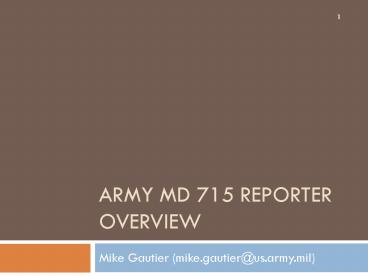Army MD 715 Reporter Overview - PowerPoint PPT Presentation
1 / 24
Title:
Army MD 715 Reporter Overview
Description:
SQL data base engine and HTML displays just click the button. EEO office hierarchy ... Form B is auto filled from the Data tables. Forms Management. 11 ... – PowerPoint PPT presentation
Number of Views:735
Avg rating:3.0/5.0
Title: Army MD 715 Reporter Overview
1
Army MD 715 Reporter Overview
- Mike Gautier (mike.gautier_at_us.army.mil)
2
What it does
- Purpose
- Reduce MD 715 Reporting Effort
- Manage forms
- Calculate data tables
- Score form G
- Does not
- Do the report (it helps assemble it)
- Do data analysis (thats our job not the
machines)
3
Background
- Designed by EEO for EEO
- EEO wrote the requirements
- CIO validated them
- HQ funded it
- Coded by Government Contractor Nortel
International under supervision of Army COTR - The Team
- Functional (EEO)
- HR HQ DA techies
- Contractor (Nortel)
4
Design Considerations
- EEOC Forms a hassle fighting more with margins
than doing the report - MD 715 wants simple answers from complex
organizations - Data tables too laborious
- How do we measure what we do
- How do we reduce the report sending
5
Design Considerations
- MD 715 is an operational model
- How can we track what we do throughout the year
- How can we show progress year to year
- How can we control the forms and concentrate on
content - How can we do data calcs efficiently using the
sheer horsepower of a real database engine while
controlling the data stream
6
Design Considerations
- Forms A-J are the report
- Data tables are an appendix not the report
- Enterprise web application (central system)
- Multi-user more than one person can use this
application at a time - Generic design keep the design simple
- HR data needs careful review
7
Design Consideration
- Kept simple
- No electronic signatures
- Exportable to MS Excel and MS Word
- Supporting documents are uploaded
- Each headquarters element can see the reports of
the next lower element - Data tables exported from Business objects -gt
text file-gtimported into reporter -gtcalculated
HTML data tables
8
Components
- Forms Management
- Form view for entering information
- MS Word view is the actual forms A-J that can be
printed - Form G Dashboard
- Scores the Form G
- Color coded results
- Data tables
- SQL data base engine and HTML displays just
click the button - EEO office hierarchy
- Each EEO office has a unique name based on
iComplaints
9
Forms Management
Forms A-J are completed either through a form
entry or by RTF (MS Word) direct entry
10
Forms Management
Form A is filled on and the user then moves to
form C
Form B is auto filled from the Data tables
11
Forms Management
Form G is scored and provides a color
coded display of the scores based on the
Agency metrics
12
Forms Management
Each element can be examined to find out what the
causes of the score are
13
Forms Management
A comment or a Form H can be developed for each
element
14
Forms Management
A form H can be completed for each element and
can be updated throughout the year
15
Forms Management
When all the forms are completed the report can
be printed in its entirety as a single MS Word
document and sent out for coordination
16
Data Tables
Each user uploads their own CLF data from the
census site and uploads their employee data as
text files. The applications database engine
calculates the data tables
17
Data Tables
The user can select the data tables they want to
report on
18
Data Tables
The data tables have the CLF loaded along with
the employee data and displays in the appropriate
table
19
Data Tables
20
Data Tables
21
Data Tables
22
Supporting Documents
The user can upload and documents used in the
report. The forms and data roll over from year to
year
23
Reporting Hierarchy
Each HQ element can see the reports of the
element below it so there is no need to send
the report to the next level
24
Contact Information
- Individual or group Demos Mike Gautier
mike.gautier_at_us.army.mil - Technical questions (techie to techie) Dave
Fretz dave.fretz_at_us.army.mil - Contractor cost questions Brent Spence
brent.spence_at_us.army.mil































